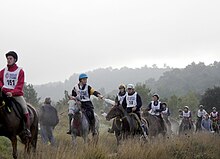Endurance riding

Competitors on an endurance ride
|
|
| Highest governing body | International Federation for Equestrian Sports (FEI) |
|---|---|
| Characteristics | |
| Contact | no |
| Team members | individual and team at international levels |
| Mixed gender | yes |
| Type | outdoor |
| Equipment | horse, appropriate horse tack |
| Venue | Outdoor natural setting, usually varied and often rugged terrain |
| Presence | |
| Country or region | Worldwide |
Endurance riding is an equestrian sport based on controlled long-distance races. It is one of the international competitions recognized by the FEI. There are endurance rides worldwide.
There are two main types of long-distance riding, competitive trail riding and endurance rides. In an endurance ride, discussed in this article, the winning horse is the first one to cross the finish line while stopping periodically to pass a veterinary check that deems the animal in good health and fit to continue. In the United States, most endurance rides are either 50 or 100 miles (160 km) long. Shorter rides, called Limited Distance rides (LD), are organized for new riders to the sport or young horses being trained. However, LD's have evolved into a competition of their own, in which more experienced riders and horses also participate. There are also longer, usually multi-day, rides as well. As with human marathon running, many riders will participate to improve their horse's personal best performance and consider finishing the distance with a proper vet completion record to be a "win". In the USA, the American Endurance Ride Conference (AERC) sanctions endurance rides. In the UK, Endurance GB is the governing body. Winning riders can complete 100-mile (160 km) rides in 14 to 15 hours.
Any breed can compete, but the Arabian generally dominates the top levels because of the breed's stamina and natural endurance abilities.
Worldwide, rules vary. Endurance rides and races can be any distance, though they are rarely over 160 km for a one-day competition.
Though the need to ride long distances has existed since the domestication of the horse, endurance riding as an organized activity was first developed in the United States based on European cavalry (particularly Polish and Russian WWI) and breeding program tests requiring the ability to carry 300 lb (140 kg) over 100 miles (160 km) in one day. Organized endurance riding as a formal sport began in 1955, when Wendell Robie and a group of equestrians rode from the Lake Tahoe area across the Sierra Nevada Range to Auburn in under 24 hours. They followed the historic Western States Trail. This ride soon became known as the Tevis Cup, and it remains the most difficult of any 100-mile ride in the world because of the severe terrain, high altitude, and 100-degree (~37 °C) temperatures. Endurance riding first was brought to Europe in the 1960s.
...
Wikipedia
